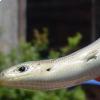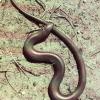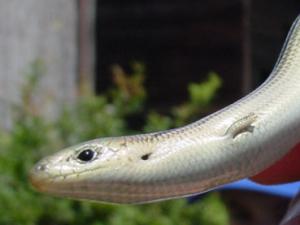La luscengola (Chalcides chalcides Linnaeus, 1758) è un piccolo sauro appartenente alla famiglia degli Scincidi, diffusa nei paesi del bacino occidentale del Mar Mediterraneo, e presente in Provincia di Salerno dove viene frequentemente avvistata presso il Parco Nazionale del Cilento e Vallo di Diano. Il suo habitat tipico è rappresentato dalle zone erbose e umide e i cespuglieti più freschi della macchia mediterranea. Quando fugge rapidissimo, scivolando a zigzag tra erbe e rocce, questo animale potrebbe essere erroneamente scambiato per un serpente. In realtà si tratta di un parente delle lucertole, appartenente al sottordine dei Sauri.
La caratteristica principale di questa specie è di possedere arti molto piccoli, pressoché atrofizzati. Il corpo, serpentiforme, lungo sino a 40 cm, lucido, ha un colore che può andare dal verde oliva al grigio, al marrone, con striature nere.
Vive in ambienti erbosi e esposti al sole, essendo un animale pecilotermo.
Non depone uova, ma è vivipara. Molto sensibile al freddo, passa l'inverno rintanata in buche riparate del terreno o in fessure tra rocce esposte a sud, da cui esce solo in primavera avanzata. Per questo stesso motivo è piuttosto rara nelle zone montane.
Si nutre soprattutto di insetti e altri invertebrati. A differenza della maggior parte degli altri Sauri (fatta eccezione per la lucertola vivipara, Lacerta vivipara, presente solo nell'arco alpino), non depone le uova, bensì partorisce fino a ventitré piccoli vivi in una volta.
Una caratteristica, invece, che la accomuna a molte altre lucertole è quella dell'autotomia, cioè il distacco della coda nel caso in cui questa venga afferrata da un predatore.

The Italian three-toed skink (Chalcides chalcides), is a small lizard belonging to the family of Scincidae, widespread in the countries of the Mediterranean Sea, and in the present Province of Salerno where it is frequently sighted at the National Park of Cilento and Vallo di Diano. It’s typical habitat is represented by grassy areas and wetlands of the Mediterranean. When this lizard is slipping zigzag between rocks and herbs, this animal could be mistaken for a snake. In reality it is a relative of lizards belonging to the suborder of Sauri.
The main feature of this species is that it has tiny feets with three little toas. The body gets up to 40 cm long it is glossy and has a color that can range from olive green to gray or brown, with black streaks.
It lives in grassy areas which are exposed to the sun.
It is very sensitive to cold, and it spends the winters in holes in the ground or repaired cracks between rocks, from here they will come out in late spring. For this same reason, it is quite rare in the mountain areas.
It feeds mainly on insects and other invertebrates. Unlike most other Sauri it does not lay eggs but give birth to already almost grown up lizards up to twenty-three lizards can be born at once.





